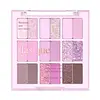What's inside
What's inside
 Key Ingredients
Key Ingredients

 Benefits
Benefits

 Concerns
Concerns

 Ingredients Side-by-side
Ingredients Side-by-side

Dimethicone
EmollientCalcium Titanium Borosilicate
AbrasiveSynthetic Fluorphlogopite
Calcium Aluminum Borosilicate
Methyl Methacrylate Crosspolymer
CI 77891
Cosmetic ColorantNeopentyl Glycol Diethylhexanoate
EmollientHexyl Laurate
EmollientDimethicone/Vinyl Dimethicone Crosspolymer
Skin ConditioningDiglyceryl Sebacate/Isopalmitate
EmollientNylon-12
Silica
AbrasiveSorbitan Sesquiisostearate
EmulsifyingDipentaerythrityl Hexahydroxystearate/Hexastearate/Hexarosinate
Skin ConditioningMagnesium Myristate
Phenoxyethanol
PreservativePropanediol
SolventSynthetic Wax
AbrasiveCI 75470
Cosmetic ColorantCI 15985
Cosmetic ColorantDimethicone, Calcium Titanium Borosilicate, Synthetic Fluorphlogopite, Calcium Aluminum Borosilicate, Methyl Methacrylate Crosspolymer, CI 77891, Neopentyl Glycol Diethylhexanoate, Hexyl Laurate, Dimethicone/Vinyl Dimethicone Crosspolymer, Diglyceryl Sebacate/Isopalmitate, Nylon-12, Silica, Sorbitan Sesquiisostearate, Dipentaerythrityl Hexahydroxystearate/Hexastearate/Hexarosinate, Magnesium Myristate, Phenoxyethanol, Propanediol, Synthetic Wax, CI 75470, CI 15985
Talc
AbrasiveCalcium Titanium Borosilicate
AbrasiveCalcium Sodium Borosilicate
Polymethyl Methacrylate
Dimethicone
EmollientMagnesium Stearate
Cosmetic ColorantNeopentyl Glycol Diethylhexanoate
EmollientHexyl Laurate
EmollientDimethicone/Vinyl Dimethicone Crosspolymer
Skin ConditioningCI 77891
Cosmetic ColorantDipentaerythrityl Hexahydroxystearate/Hexastearate/Hexarosinate
Skin ConditioningCaprylyl Glycol
EmollientTin Oxide
AbrasiveGlyceryl Caprylate
EmollientMica
Cosmetic ColorantEthylhexylglycerin
Skin ConditioningSynthetic Fluorphlogopite
CI 77491
Cosmetic ColorantCI 15850
Cosmetic ColorantTocopherol
AntioxidantPolybutylene Terephthalate
Bis-Diglyceryl Polyacyladipate-2
EmollientCalcium Aluminum Borosilicate
Ethylene/Va Copolymer
Emulsion StabilisingAcrylates Copolymer
Polyglyceryl-2 Triisostearate
EmulsifyingSilica
AbrasiveDiisostearyl Malate
EmollientMagnesium Myristate
CI 77007
Cosmetic ColorantTriethoxycaprylylsilane
CI 73360
Cosmetic ColorantCI 19140
Cosmetic ColorantWater
Skin ConditioningSodium Chloride
MaskingSodium Sulfate
Caprylic/Capric Triglyceride
MaskingHydrogenated Castor Oil Isostearate
Skin ConditioningNylon-12
CI 77742
Cosmetic ColorantKaolin
AbrasiveUltramarines
Titanium Dioxide
Cosmetic ColorantCI 77492
Cosmetic ColorantCaesalpinia Sappan Bark Extract
Skin ConditioningCI 77510
Cosmetic ColorantPolyethylene Terephthalate
CI 77499
Cosmetic ColorantTriethylhexanoin
MaskingTalc, Calcium Titanium Borosilicate, Calcium Sodium Borosilicate, Polymethyl Methacrylate, Dimethicone, Magnesium Stearate, Neopentyl Glycol Diethylhexanoate, Hexyl Laurate, Dimethicone/Vinyl Dimethicone Crosspolymer, CI 77891, Dipentaerythrityl Hexahydroxystearate/Hexastearate/Hexarosinate, Caprylyl Glycol, Tin Oxide, Glyceryl Caprylate, Mica, Ethylhexylglycerin, Synthetic Fluorphlogopite, CI 77491, CI 15850, Tocopherol, Polybutylene Terephthalate, Bis-Diglyceryl Polyacyladipate-2, Calcium Aluminum Borosilicate, Ethylene/Va Copolymer, Acrylates Copolymer, Polyglyceryl-2 Triisostearate, Silica, Diisostearyl Malate, Magnesium Myristate, CI 77007, Triethoxycaprylylsilane, CI 73360, CI 19140, Water, Sodium Chloride, Sodium Sulfate, Caprylic/Capric Triglyceride, Hydrogenated Castor Oil Isostearate, Nylon-12, CI 77742, Kaolin, Ultramarines, Titanium Dioxide, CI 77492, Caesalpinia Sappan Bark Extract, CI 77510, Polyethylene Terephthalate, CI 77499, Triethylhexanoin
 Reviews
Reviews

Ingredients Explained
These ingredients are found in both products.
Ingredients higher up in an ingredient list are typically present in a larger amount.
Calcium Aluminum Borosilicate is made up of calcium, aluminum, and silicates. It is a glass-like material. In cosmetics, it comes in the form of flakes or microspheres.
Calcium aluminum borosilicate is a bulking agent, meaning it helps thicken a product.
This ingredient is created by slowly mixing several minerals, including kaolin clay.
Although “aluminum” in an ingredient name can raise red flags for some consumers, the form and usage context matter significantly. For typical topical applications, there is no substantial evidence of health risks - such as cancer, neurotoxicity, or systemic “aluminum overload.”
Learn more about Calcium Aluminum BorosilicateCalcium Titanium Borosilicate is an exfoliant.
Ci 77891 is a white pigment from Titanium dioxide. It is naturally found in minerals such as rutile and ilmenite.
It's main function is to add a white color to cosmetics. It can also be mixed with other colors to create different shades.
Ci 77891 is commonly found in sunscreens due to its ability to block UV rays.
Learn more about CI 77891Dimethicone is a type of synthetic silicone created from natural materials such as quartz.
What it does:
Dimethicone comes in different viscosities:
Depending on the viscosity, dimethicone has different properties.
Ingredients lists don't always show which type is used, so we recommend reaching out to the brand if you have questions about the viscosity.
This ingredient is unlikely to cause irritation because it does not get absorbed into skin. However, people with silicone allergies should be careful about using this ingredient.
Note: Dimethicone may contribute to pilling. This is because it is not oil or water soluble, so pilling may occur when layered with products. When mixed with heavy oils in a formula, the outcome is also quite greasy.
Learn more about DimethiconeThis ingredient is a silicone used to improve the texture of products and absorb oil. It does not get absorbed into the skin.
Like other silicones, Dimethicone/Vinyl Dimethicone Crosspolymer helps condition the skin by creating a barrier. In this sense, it can act as an emollient and trap moisture in.
This ingredient is a type of elastomer.
Learn more about Dimethicone/Vinyl Dimethicone CrosspolymerWe don't have a description for Dipentaerythrityl Hexahydroxystearate/Hexastearate/Hexarosinate yet.
Hexyl Laurate isn't fungal acne safe.
We don't have a description for Magnesium Myristate yet.
Neopentyl Glycol Diethylhexanoate is an emollient and texture enhancer. Emollients help hydrate the skin by creating a barrier on top. This barrier prevents moisture from escaping, keeping the skin hydrated.
It is the diester of neopentyl glycol and 2-ethylhexanoic acid.
Nylon-12 is a polymer. It is derived from 12-aminododecanoic acid, an omega-amino fatty acid
According to a manufacturer, it is a talc substitute. Like talc, nylon-12 gives products a satin feel. The manufacturer also claims this ingredients does not block pores and has moderate oil absorption.
This ingredient may not be reef-safe.
Learn more about Nylon-12Silica, also known as silicon dioxide, is a naturally occurring mineral. It is used as a fine, spherical, and porous powder in cosmetics.
Though it has exfoliant properties, the function of silica varies depending on the product.
The unique structure of silica enhances the spreadability and adds smoothness, making it a great texture enhancer.
It is also used as an active carrier, emulsifier, and mattifier due to its ability to absorb excess oil.
In some products, tiny microneedles called spicules are made from silica or hydrolyzed sponge. When you rub them in, they lightly polish away dead skin layers and enhance the penetration of active ingredients.
Learn more about SilicaSynthetic Fluorphlogopite is the synthethic version of mica. It consists of fluorine, aluminum and silicate.
Synthetic Fluorphlogopite is used to add volume to products.
It is considered non-irritating on the skin.
Learn more about Synthetic Fluorphlogopite